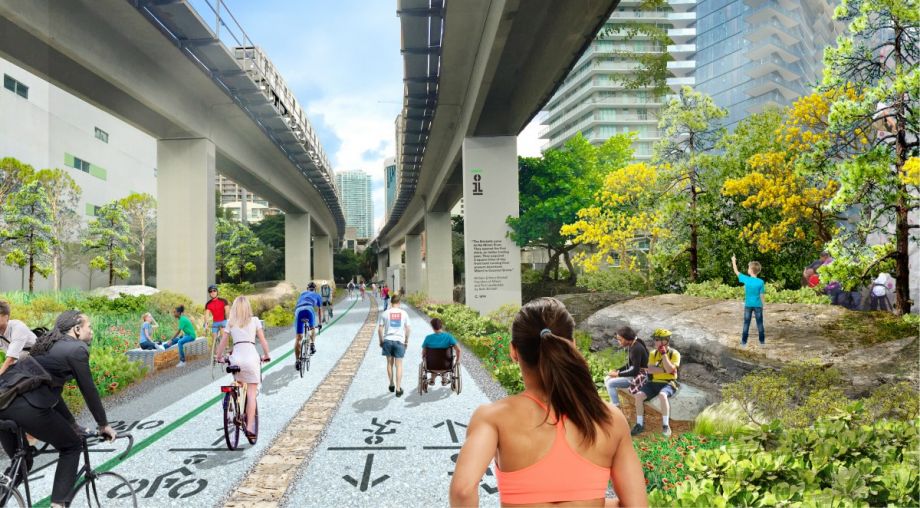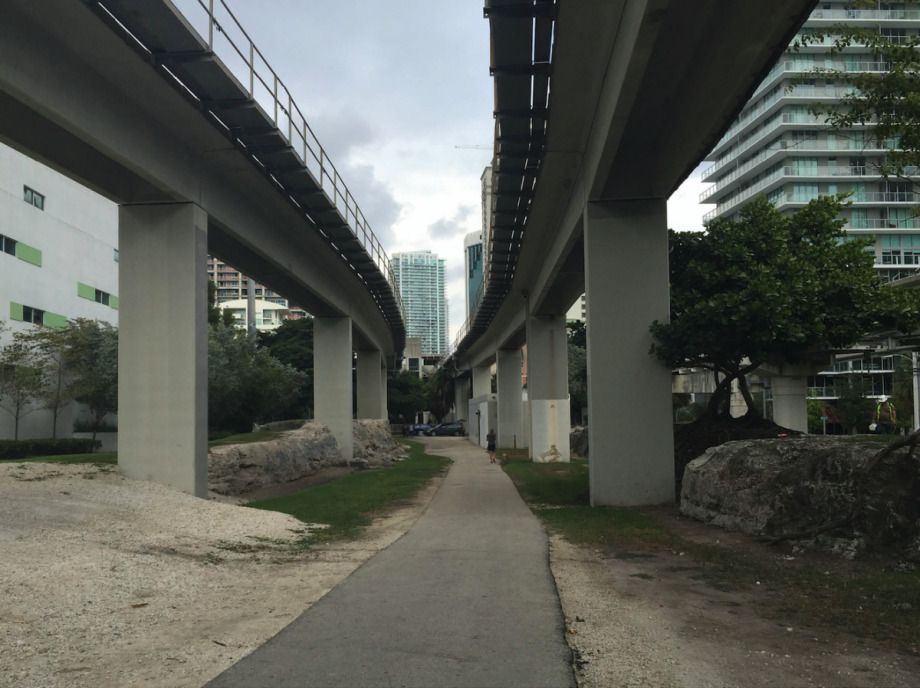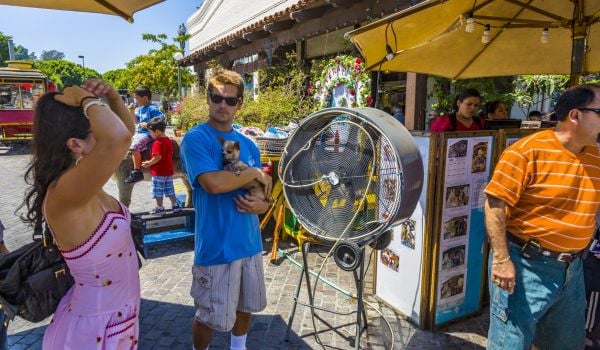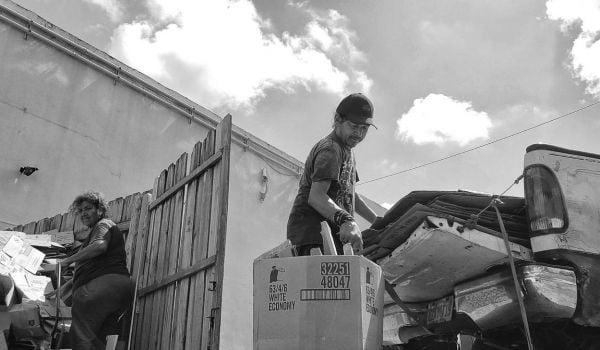Miami’s newest infrastructure project happened after Meg Daly broke both her arms.
“I couldn’t do anything for myself for a while,” Daly says. After three weeks of getting driven to physical therapy, she decided to hop on Miami’s Metrorail, a mostly elevated rail system.
“I ended up taking the train, getting off and then walking below the train above me,” Daly says. That’s when she noticed the undeveloped land beneath the train. “I was like: Why aren’t we doing something with this land?”
So she thought of the idea for the Underline, a 10-mile, 120-acre linear park with a walking and biking path that will be built under the rail tracks. The Underline, plans to connect South Miami, Coral Gables and downtown Miami, follows in the footsteps of projects such as New York City’s High Line and Atlanta’s BeltLine. Daly founded the nonprofit Friends of the Underline in 2015 in order to partner with Miami-Dade County — who owns the land — and secure funds for ongoing operations.
After years of planning and having discussions with the community, the Underline broke ground on Nov. 1, 2018, with the first half-mile segment now under construction. The management, maintenance and programming of the Underline will be run by the Underline Management Organization, a nonprofit represented by Friends of The Underline, Miami-Dade County, the Florida Department of Transportation, the Federal Transit Administration and three municipalities.
Design is not the only aspect that the Underline shares with “rails-to-trails” projects around the U.S. The BeltLine and the High Line have both grappled with concerns of lessened affordability and increased gentrification — and the Underline will have to grapple with it as well.
Affordable housing, along with sea level rise, has been a top challenge in Miami for more than a decade, says Ned Murray, associate director of Florida International University’s Metropolitan Center.
“This issue is very significant and one that needs to be addressed and one that has to be addressed locally. There is no federal or state level of funding or anything that could come out of Washington and Tallahassee that could really help with this,” says Murray, who has studied affordable housing issues in South Florida. “More and more states and cities around the country are now looking at solutions that are local, more innovative policy and financing solutions.”
He says in recent years, gentrification has become more aggravated in Miami because of a lack of land for real estate developers. The neighborhoods surrounding the Underline already tend to be higher income.
“Land is precious down here, and obviously it’s been eaten up by high-rent real estate development,” Murray says.
To address this, the city has an affordable housing master plan, including a $100 million bond for affordable housing and economic development.
Daly says the Underline is taking steps to alleviate affordability issues. Friends of the Underline is about to embark on a study looking at neighborhood connectivity, accessibility and equitable growth, which will also explore a component for workforce and affordable housing. Daly hopes to complete the study by the third quarter of 2019.
The Underline is also a member of the High Line Network, an organization of infrastructure reuse projects that has developed an equitable impact framework.
“[In] Miami, we’re luxury apartments. Everything’s a luxury apartment,” Daly says. “You’re in the urban core and since our county’s so big, more affordable housing just gets pushed out west close to the Everglades and then those folks have a two-hour commute. To us, that’s not a solution.”
Grove Central is one mixed-use development that will be built alongside the Underline in Coconut Grove. At least 15 percent of the apartment units will be workforce housing for residents earning 60 to 140 percent of Miami-Dade County’s area median income. (The county’s workforce housing development program is voluntary and provides this definition.)
“You don’t want to have a city or a neighborhood that’s purely one-dimensional, one income demographic,” says David Martin, president of Terra, the real estate development company behind Grove Central. “You want to have a mix.”
Martin, who is a Friends of the Underline board member, says the workforce housing rent will range from $1,400 to $2,100 depending on the apartment’s size. Average rent in Coconut Grove is $2,312, according to RentCafe.
The Underline has the potential to change the appearance of Miami. When Teri Williams looks outside her office, she sees the land under the Metro. “At this moment, it’s very gray, not used in a very creative way at all,” she says, adding that the Underline and similar projects make communities more attractive.
But affordability is a concern, says Williams, president and chief operating officer of OneUnited Bank, the largest black-owned bank in the country. Over the years, buying a home in Miami has become more expensive. “We’ve seen an increase in home prices, but what we haven’t seen is an increase in wages and an increase in salaries commensurate with the increase in home prices,” she says.
The Underline needs to continue to push affordable housing initiatives so everyone can benefit from the amenity, Williams says.

A rendering of the proposed Underline's route through Miami-Dade County. (Credit: 2018 James Corner Field Operations, courtesy, Friends of The Underline)
Murray says Miami also needs transportation alternatives to relieve congestion. The Underline could help with this need in the neighborhoods surrounding it.
“They’ve pretty much already been developed and now it’s really a question of how to ease the pain, so to speak, in terms of not only traffic but the devising alternative means of transportation,” he says. “Certainly anything that improves transportation is going to be looked at in a positive way.”
For now, Daly is getting ready to have public meetings with the communities around the next 2.25-mile segment of the Underline. She says it’s important to address affordability and density with the project and looks forward to the day when her son, daughter-in-law and grandson will live along the route.
“If we don’t solve big problems and we’re a big project, I think that we have failed,” Daly says. “Failing’s not an option.”
This story is part of The Power of Parks, a series exploring how parks and recreation facilities and services can help cities achieve their goals in wellness, conservation and social equity. The Power of Parks is supported by a grant from the National Recreation and Park Association.

Adina Solomon is a freelance journalist based in Atlanta. She writes on a range of topics with specialties in city design, business and death. Her work has appeared in The Washington Post, CityLab, U.S. News & World Report, and other national and local outlets.
















